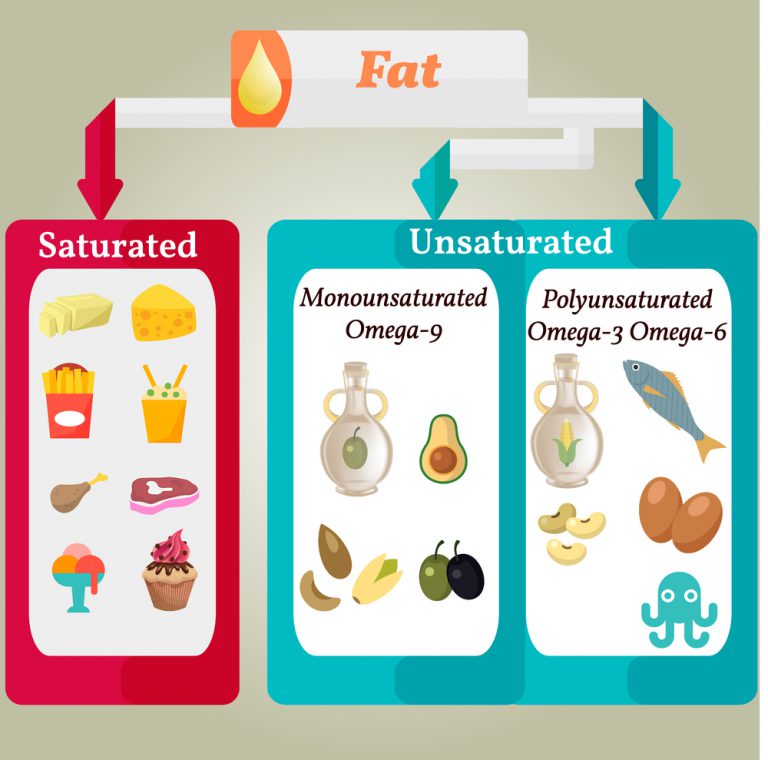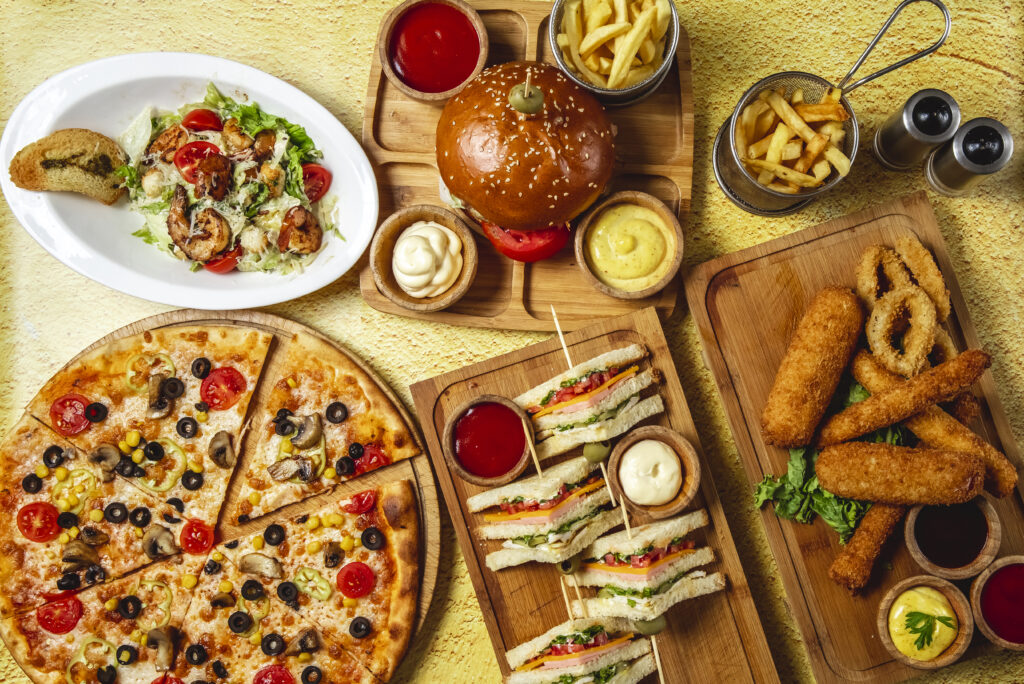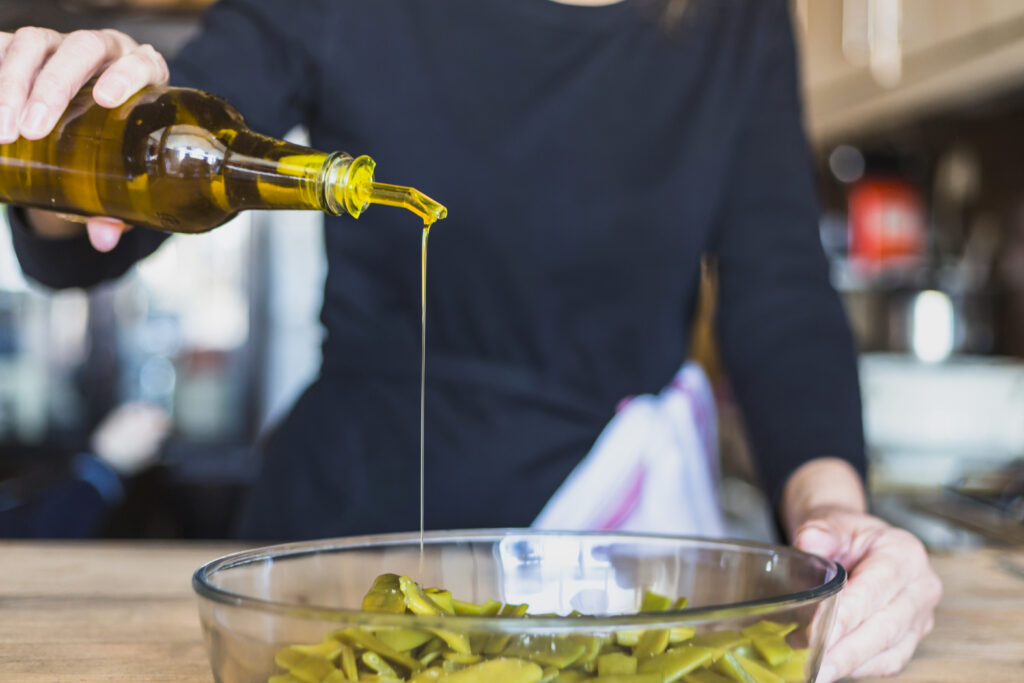Did you know that your body needs fats to function properly?
Did you know that many of the modern diseases could be a result of a lack of good quality fats?
Did you know that it actually makes a difference which fats you consume and how you cook with them?
Triglycerides, which lipids are made up of, are made in the liver and stored when they have not been used for energy.
If the triglyceride is liquid at room temperature it is called an oil, if it is solid, it is called a fat.
Excess carbohydrates that are not needed to make energy (ATP) become stored fat in the adipose tissue. Excess protein that is not used for tissue building and repair, is dealt with differently.
Most of the fat is broken down in the small intestine by enzymes called lipase after the bile acids have emulsified them. Various forms of the fats travel through the intestinal walls and into the lymph system and are re-made into triglycerides. The long-chain fatty acids must be transported to the liver through the lymph via chylomicrons but the short and medium chain fatty acids can go directly into the portal blood and to the liver for energy production. Once the long chain fatty acids arrive at the liver they can be broken down again into ATP. This process is called beta oxidation. If this energy is not needed at the time, it is stored as triglycerides in adipose tissue.
Unlike carbohydrate digestion, fats allow for a slow release of energy, which lasts for a longer period of time. This also allows for the body to absorb more of the nutrients that come with fats (fat soluble vitamins). Usually, when consuming healthy fats, one tends to become satiated and does not tend to overeat. In other words, it’s easier to consume excess carbohydrates than fats, and they are more likely to contribute to your adipose tissue.
The concern about Saturated Fats clogging things up (like arteries) is patently unsubstantiated. Firstly, no edible fats are 100% anything. They are all a mixture of saturated, monosaturated and polysaturated fats. For example, olive oil is 15% saturated, 73% monosaturated, and 10% polyunsaturated. Lard is 44% saturated, 45%monosaturated and 11% polyunsaturated. Apparently they are named by their predominant fat.
Dr. Mary Enig, lipid biochemistry expert, who spent her life studying the subject, put it well…. “The idea that saturated fats cause heart disease is completely wrong, but the statement has been ‘published’ so many times over the last three or more decades that it is very difficult to convince people otherwise unless they are willing to take the time to read and learn what all the economic and political facts were that produced the anti-saturated-fat agenda”.

Saturated fats have been demonized by the industrialized food industry (perhaps for monetary reasons), when actually the opposite is true. We absolutely need good fats to be healthy. Heart disease is a result of synthetic, poor quality fats and a lack of good fats, which contributes to inflammation. Cholesterol alone is not the enemy. It is the combination of high blood triglycerides, and high levels of inflammatory markers (c-reactive protein-which is not commonly checked) that create a dangerous situation. The cholesterol is merely the agent trying to patch up the damage done by inflammation.
Besides the benefits listed below, saturated fats are heat stable and not easily oxidized (not likely to react chemically with oxygen and become rancid.) Whereas, trans fats, which are polyunsaturated fats that have been heated and chemically altered, are rancid and actually cause many problems. (like inflammation). The most abundant, and commonly used polyunsaturated in the processed food world are mostly omega -6s. Oils such as soybean, canola, corn, cottonseed, sunflower and safflower are cheap to produce and widely used (and genetically modified). They lower the HDL cholesterol (the so-called good) and raise the dangerous LDL cholesterol (LP(a). Besides disrupting cellular function on many levels, transfats have been tied to heart disease, diabetes, cancer, low birth weight, obesity, and immune dysfunction. In the discussion of inflammation though, the quality of the oil can make or break the situation. You need all of the omegas but it is the quality of them that is the key to the inflammatory control function of prostaglandins. Since the saturated fats are more stable, the concern is more with the fragile polyunsaturated. I cannot stress enough the importance of organically grown, properly processed oils. Don’t heat the vegetable oils, except for avocado, coconut, palm, and olive (at low heat).
When you feed cell membranes low quality materials, there are consequences.
Inflammation that is produced by poor fats cannot be resolved without good fats.
If you are following the growing current research on the importance of good quality foods on our health, you might have heard that butter is now acceptable in the mainstream world. Traditional societies have used fats since the beginning of time and did not suffer from diseases such as obesity and diabetes. The latest research points to the modern synthetic diet as a major causative factor in modern diseases. Amazing enough, the rise of these polyunsaturated oils coincides with the rise of epidemic cardiovascular disease. MI’s (myocardial Infarctions), were rare in the beginning of the 1900’s. When the food processing industry flooded the media with their self-funded “lipid hypothesis” studies, animal fats became a bad word in this country. The French did not seem to adhere to these rules and continued on with their high fat crèmes, pates, and other delicious foods. In the Gascony Region, where the French are consuming large amounts of duck and goose liver, the rate of coronary heart disease is remarkably low at 80 per 100,000.* There are many examples of this around the world.
No one stopped to study the research more carefully (took direction from the food industry) and wonder why this sudden switch in American diet that had sustained us for so long.
The bottom line is, besides inflammatory issues– No fats, No fat-soluble vitamins and a lot of other systems not working.
These vitamins such as A, D, E, K, are so invaluable that we actually cannot survive without them. They are major components of the foods that once were commonly consumed, but have been avoided in the last 60 or more years.
NO eggs, No butter, No lard, No tallow, No bacon, No whole milk?
What Did we Eat?
Actually we ate a lot of fake stuff. You could not really call it food, because it had no nutritional value, not very good taste, and not many ingredients that were not chemicals (but people got addicted to salt and sugar, so it tasted good to them). These laboratory created substances still line the shelves of most supermarkets.
Have you ever heard of the example of the margarine and the butter that are left outside for several days? The wild animals don’t go near the margarine, but the butter was completely devoured. Perhaps the animals are smarter than we are, or maybe their taste buds have not been sabotaged.
Fatty Acids (Lipids) do a lot of good for our bodies.
1. Every cell in the body is made-up of an outer lipid layer; which are made of fatty acids. The structure of the membranes are of key importance to its function.
2. Cholesterol, made of fatty acids, is a main component of the cell membrane. The flexibility and endurance of these membranes depends upon a healthy and stable fatty acid supply. If the source is of poor quality, such as in transfats, the membranes are compromised. That means it is hard for nutrients to get absorbed and hard for toxic materials to leave………..
3. Manufacture of healthy cholesterol and healthy bile supports good liver function .
4. Cholesterol is the major building block of all steroid hormones; which are the sex hormones.
5. The body needs cholesterol to produce Vitamin D on the skin surface in response to UVB radiation from the sun.
6. Brain is 60% fat
7. You need healthy fat in order to absorb fat-soluble vitamins.
8. You do not get fat from eating fat, in fact the opposite is true.
9. Adequate use of proteins depend on fats
10. Management of the inflammatory processes
11. Protective lining for all the organs of the body
12. Eating fat with your foods makes it taste so much better.
13. Eating fat with a meal helps it to last longer in your system, hence you stay satisfied longer and your blood sugar stays balanced.
Think, slow burning log rather than kindle.
Omega 3s (polyunsaturates)
Sources: Fish oil, Pumpkin, flax seed oil, walnut, hemp
Omega 6s (polyunsaturates)
Sources: sunflower oil, sesame oil, safflower oil, peanut oil, black current seed, evening primrose, borage.
Omega 9s (polyunsaturates)
Sources: Extra virgin oil, hazelnut oil, almond oil, avocado oil
Saturated
Sources: animal fats, raw dairy, butter, coconut oil, eggs, palm oil.

The Fat Soluble Vitamins Produced
Fat Soluble Vitamin D
1. The functions of vitamin D are numerous and they are obtained
best through animal fats.
2. Vitamin D is really a steroid hormone that controls expression of two hundred genes and the proteins those genes regulate.
3. It is crucial for mineral metabolism; working with Vit A and Vit K to absorb calcium, magnesium, and phosphorus, and deliver them to the right place in the body.
4. Vitamin D promotes calcium absorption from the intestines and assists the parathyroid hormone to maintain proper blood calcium levels.
5. Vitamin D even contributes to neurotransmitter biosynthesis, as in serotonin.
6. Vitamin D plays an important role in immunity, cell growth and healing, and therefore its deficiency is now being tied to autoimmune disease.
Sources: liver and other organ meats, pastured eggs, raw cheese, butter, marine oils, seafood (especially shrimp and crab).
Fat Soluble Vitamin A
1. Converted from dietary retinol to retinal.
2. Promotes vision, and a deficiency can lead to blindness,
3. Skin health – maintenance of the structure and function of the epithelial tissues that line the inside and outside of the body.
Think – almost every bodily organ including respiratory.
4. Retinol boosts immunity through tissue maintenance, and production of antibodies and white blood cells.
5. Bones and teeth are dependent on vitamin A for the remodeling process. Vitamin A works in conjunction with vitamin D and vitamin K to repair and retain bone material.
6. Crucial for nearly all parts of the developing fetus.
7. In the reproductive system it is essential for the production of hormones and sperm production, and it even assists in a healthy gestation process.
8. Vitamin A promotes cell differentiation, which inhibits tumor development and can therefore protect against cancer.
9. Beta-carotene is not a good source of vitamin A; not much of it can get converted to retinol. It has other beneficial uses though.
Sources: cod liver oil, liver and other organ meats, pastured eggs, raw cheese, butter
Fat Soluble Vitamin E
1 .Main role in the immure system in its antioxidant activity.
2. It is a lipid-soluble antioxidant and protects against free radical damage to long-chain polyunsaturated fatty acids in the membranes of cells. (think, denatured vegetable oils)
3. The more denatured polyunsaturated fats you eat, the more E you need.
4. Vitamin E plays a role in the release of hormones from the pituitary gland.
5. Sources: unrefined vegetable oils, liver and other organ meats, pastured eggs, raw cheese, grains, nuts, seeds, legumes and dark green leafy vegetables
Vitamin K2 – Needs Fat Soluble Vitamins to be Activated
1. There are many newly discovered forms of vitamin K that are still being researched. Phylloquinone (K1) is the most well known for its role in blood clotting. Menaquinine (K2) has just recently been given its attention due.
2. K2 was discovered by Dr. Weston A. Price in the early 1900’s (named activator X), but it was not analyzed seriously by the medical community.
3. It is now known that this vitamin contains crucial activating roles in bone and dental health- calcium metabolism.
4. Proper calcium metabolism, which affects numerous systems in the body, is K2-dependent. The proteins which are responsible for the deposition of calcium and phosphorus into the bones and teeth are dependent on K2 to be activated. The proteins which are responsible for moving calcium out of soft tissue are also dependent on K2 to be activated. (think -the heart vessels).
5. Proper facial development in utero is dependent on K2.
6. If the K2-dependent proteins are not activated they can initiate diseases related to calcium metabolism.
7. Linked to Alzheimer’s Disease, wrinkles, decreased kidney filtration, varicose veins, hemorrhoids. (Calcium deposits in the wrong places).
Sources: grass –fed butter and ghee, raw cheese, raw fermented vegetables such as sauerkraut, Liver, natto, goose liver pate, pastured eggs, goose, grass- fed beef, wild game.
How, you may ask, did we miss these so very important nutrients?
The answer usually comes back to the same thing.
Our traditional foods sources that our bodies were evolutionarily designed to handle have been altered. We have not been eating the foods that Mother Nature provided us in our surroundings. We have messed with nature! In fear of fat – we removed the skin on the chicken (the best part) and settled for that dry boneless/skinless variety. We ate those cholesterol free egg whites (eck), fat free milk (might as well drink water), margarine (I never did), fat- free sour crème (what’s the point?), coffee creamer (ruins the coffee), low fat cheese (no brie?) and the list goes on.
This approach to food took all the joy out of eating and created unnecessary illness. This is why nutrition educators have such an important role in today’s healthcare. We feel that if people re-learned the basics of healthy eating we could return to a culture of healthy strong-minded individuals.
General Guidelines for eating healthy fats.
1. Use saturated fats for high heat – Butter/ghee, tallow, lard, chicken, duck, red palm oil, coconut oil.
2. Use polyunsaturates (never heat) – for salads, dressings, dips, walnut, almond, flax seed, pumpkin, evening primrose, black current.
3. Use olive, avocado, sunflower sesame for low heat only (sautéing, stir fry)
4. Never use the unstable, processed oils – canola, soybean, corn, cottonseed, or any partially hydrogenated fats.
5. Always use organic oils, properly processed (unheated), fats from pastured organically raised animals.
So, the message is to enjoy your food !!
*’Vitamin K2 and the Calcium Paradox’, Kate Rheame-Bleue, B.Sc,.ND
*‘Nourishing Traditions’, Sally Fallon
*‘Put Your Heart in Your Mouth’, Dr. Natasha Campbell-McBride
Shelley H. Lane, OMD, L.Ac. NTP




